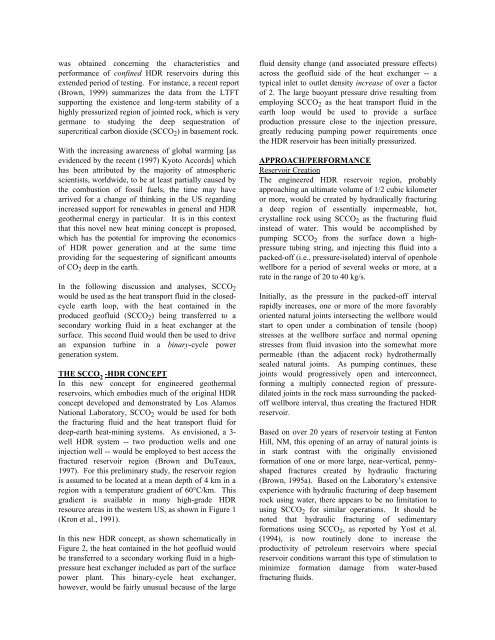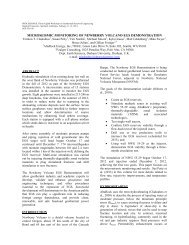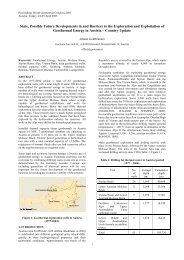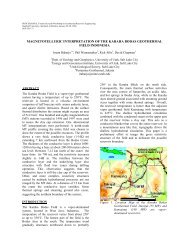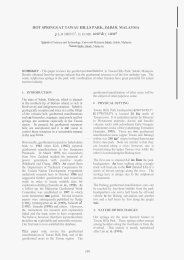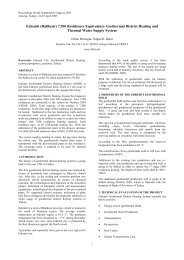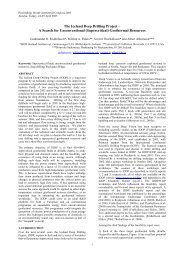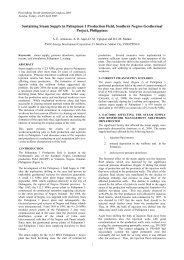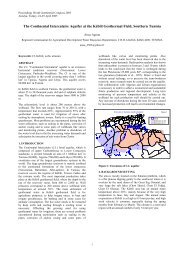A HOT DRY ROCK GEOTHERMAL ENERGY CONCEPT UTILIZING ...
A HOT DRY ROCK GEOTHERMAL ENERGY CONCEPT UTILIZING ...
A HOT DRY ROCK GEOTHERMAL ENERGY CONCEPT UTILIZING ...
Create successful ePaper yourself
Turn your PDF publications into a flip-book with our unique Google optimized e-Paper software.
was obtained concerning the characteristics and<br />
performance of confined HDR reservoirs during this<br />
extended period of testing. For instance, a recent report<br />
(Brown, 1999) summarizes the data from the LTFT<br />
supporting the existence and long-term stability of a<br />
highly pressurized region of jointed rock, which is very<br />
germane to studying the deep sequestration of<br />
supercritical carbon dioxide (SCCO 2 ) in basement rock.<br />
With the increasing awareness of global warming [as<br />
evidenced by the recent (1997) Kyoto Accords] which<br />
has been attributed by the majority of atmospheric<br />
scientists, worldwide, to be at least partially caused by<br />
the combustion of fossil fuels, the time may have<br />
arrived for a change of thinking in the US regarding<br />
increased support for renewables in general and HDR<br />
geothermal energy in particular. It is in this context<br />
that this novel new heat mining concept is proposed,<br />
which has the potential for improving the economics<br />
of HDR power generation and at the same time<br />
providing for the sequestering of significant amounts<br />
of CO 2 deep in the earth.<br />
In the following discussion and analyses, SCCO 2<br />
would be used as the heat transport fluid in the closedcycle<br />
earth loop, with the heat contained in the<br />
produced geofluid (SCCO 2 ) being transferred to a<br />
secondary working fluid in a heat exchanger at the<br />
surface. This second fluid would then be used to drive<br />
an expansion turbine in a binary-cycle power<br />
generation system.<br />
THE SCCO 2 -HDR <strong>CONCEPT</strong><br />
In this new concept for engineered geothermal<br />
reservoirs, which embodies much of the original HDR<br />
concept developed and demonstrated by Los Alamos<br />
National Laboratory, SCCO 2 would be used for both<br />
the fracturing fluid and the heat transport fluid for<br />
deep-earth heat-mining systems. As envisioned, a 3-<br />
well HDR system -- two production wells and one<br />
injection well -- would be employed to best access the<br />
fractured reservoir region (Brown and DuTeaux,<br />
1997). For this preliminary study, the reservoir region<br />
is assumed to be located at a mean depth of 4 km in a<br />
region with a temperature gradient of 60°C/km. This<br />
gradient is available in many high-grade HDR<br />
resource areas in the western US, as shown in Figure 1<br />
(Kron et al., 1991).<br />
In this new HDR concept, as shown schematically in<br />
Figure 2, the heat contained in the hot geofluid would<br />
be transferred to a secondary working fluid in a highpressure<br />
heat exchanger included as part of the surface<br />
power plant. This binary-cycle heat exchanger,<br />
however, would be fairly unusual because of the large<br />
fluid density change (and associated pressure effects)<br />
across the geofluid side of the heat exchanger -- a<br />
typical inlet to outlet density increase of over a factor<br />
of 2. The large buoyant pressure drive resulting from<br />
employing SCCO 2 as the heat transport fluid in the<br />
earth loop would be used to provide a surface<br />
production pressure close to the injection pressure,<br />
greatly reducing pumping power requirements once<br />
the HDR reservoir has been initially pressurized.<br />
APPROACH/PERFORMANCE<br />
Reservoir Creation<br />
The engineered HDR reservoir region, probably<br />
approaching an ultimate volume of 1/2 cubic kilometer<br />
or more, would be created by hydraulically fracturing<br />
a deep region of essentially impermeable, hot,<br />
crystalline rock using SCCO 2 as the fracturing fluid<br />
instead of water. This would be accomplished by<br />
pumping SCCO 2 from the surface down a highpressure<br />
tubing string, and injecting this fluid into a<br />
packed-off (i.e., pressure-isolated) interval of openhole<br />
wellbore for a period of several weeks or more, at a<br />
rate in the range of 20 to 40 kg/s.<br />
Initially, as the pressure in the packed-off interval<br />
rapidly increases, one or more of the more favorably<br />
oriented natural joints intersecting the wellbore would<br />
start to open under a combination of tensile (hoop)<br />
stresses at the wellbore surface and normal opening<br />
stresses from fluid invasion into the somewhat more<br />
permeable (than the adjacent rock) hydrothermally<br />
sealed natural joints. As pumping continues, these<br />
joints would progressively open and interconnect,<br />
forming a multiply connected region of pressuredilated<br />
joints in the rock mass surrounding the packedoff<br />
wellbore interval, thus creating the fractured HDR<br />
reservoir.<br />
Based on over 20 years of reservoir testing at Fenton<br />
Hill, NM, this opening of an array of natural joints is<br />
in stark contrast with the originally envisioned<br />
formation of one or more large, near-vertical, pennyshaped<br />
fractures created by hydraulic fracturing<br />
(Brown, 1995a). Based on the Laboratory’s extensive<br />
experience with hydraulic fracturing of deep basement<br />
rock using water, there appears to be no limitation to<br />
using SCCO 2 for similar operations. It should be<br />
noted that hydraulic fracturing of sedimentary<br />
formations using SCCO 2 , as reported by Yost et al.<br />
(1994), is now routinely done to increase the<br />
productivity of petroleum reservoirs where special<br />
reservoir conditions warrant this type of stimulation to<br />
minimize formation damage from water-based<br />
fracturing fluids.


